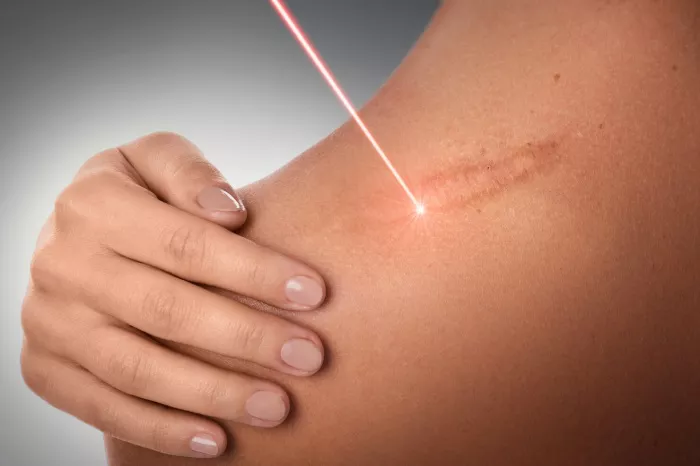Scars, a natural part of the skin’s healing process, can vary in depth, size, and appearance. While superficial scars may fade relatively quickly, deep scars pose a unique set of challenges in terms of healing. Individuals grappling with the aftermath of deep wounds often seek answers to a common question: How long do deep scars take to heal? In this comprehensive guide, we explore the factors influencing the healing timeline for deep scars, the stages of scar maturation, and proactive measures individuals can take to support the optimal healing of these more substantial skin injuries.
Understanding Deep Scars: A Complex Healing Journey
1. Formation of Deep Scars
Deep scars, often the result of significant injuries, surgeries, or traumatic events, extend beyond the superficial layers of the skin. These scars involve the deeper dermal layers, impacting the collagen matrix and structural integrity of the skin. The complexity of deep scars stems from the depth and extent of tissue damage, requiring a more intricate healing process.
2. Factors Influencing Healing Time
The duration it takes for deep scars to heal can vary significantly based on individual factors and the nature of the wound. Key influencers include:
A. Wound Size and Depth:
Larger and deeper wounds generally take longer to heal.
B. Wound Type:
Surgical incisions may have a different healing timeline than wounds resulting from trauma.
C. Individual Healing Response:
The body’s ability to regenerate tissues varies among individuals.
D. Location of the Scar:
Scars in areas with greater movement may take longer to heal due to constant tension.
3. Stages of Scar Maturation
Deep scars undergo a series of stages during the healing process. Understanding these stages provides insight into the overall timeline of scar maturation:
A. Inflammatory Phase:
Initial response to injury, involving blood clotting and immune response.
B. Proliferative Phase:
Collagen production and tissue regeneration occur, forming the scar tissue.
C. Remodeling Phase:
The scar tissue undergoes changes to align with the surrounding skin.
Timeline for Healing Deep Scars: What to Expect
1. Short-Term Healing (0-3 Months):
A. Initial Closure:
During the first few days, the wound edges come together, and the body initiates the inflammatory response.
B. Early Collagen Formation:
Collagen synthesis begins, contributing to the formation of scar tissue.
C. Wound Care Importance:
Proper wound care, including keeping the wound clean and protected, is crucial during this phase.
2. Mid-Term Healing (3-6 Months):
A. Collagen Maturation:
Collagen fibers continue to mature, and the scar tissue gradually gains strength.
B. Scar Appearance Changes:
The scar may appear raised, red, or darker during this stage.
C. Scar Massage and Topical Treatments:
Scar massage and the application of topical treatments may be recommended to promote optimal collagen alignment.
3. Long-Term Healing (Beyond 6 Months):
A. Scar Remodeling:
The scar undergoes further remodeling, and its appearance gradually improves.
B. Fading of Scar Color:
The redness or darkness of the scar typically fades over time.
C. Continued Scar Care:
Ongoing scar care, including sun protection, helps maintain optimal scar health.
Proactive Measures to Support Deep Scar Healing
1. Early Intervention:
A. Seek Prompt Medical Attention:
For deep wounds, prompt medical attention reduces the risk of complications and supports optimal healing.
B. Surgical Techniques:
In surgical cases, utilizing techniques that minimize tissue trauma can contribute to improved healing.
2. Wound Care Practices:
A. Gentle Cleaning:
Keep the wound clean with mild soap and water to prevent infection.
B. Antibiotic Ointments:
Use antibiotic ointments as recommended by healthcare professionals to prevent infection.
3. Scar Management Strategies:
A. Silicone-Based Products:
Silicone-based gels or sheets create a protective barrier, aiding in moisture regulation and collagen synthesis.
B. Vitamin E:
Topical application of vitamin E may support antioxidant activity and contribute to scar healing.
4. Scar Massage Techniques:
A. Gentle Massaging:
Massaging the scar promotes optimal collagen alignment and reduces adhesions.
B. Circular Motions:
Using circular motions during scar massage can enhance blood circulation in the area.
5. Sun Protection:
A. Sunscreen Application:
Protecting the scar from sun exposure minimizes the risk of pigmentation changes.
B. Clothing Coverage:
Use clothing or bandages to shield the scar from direct sunlight.
6. Consistent Follow-Up:
A. Healthcare Provider Consultations:
Regular follow-ups with healthcare providers ensure proper monitoring of the healing process.
B. Adjustment of Scar Management Plan:
Healthcare professionals may adjust the scar management plan based on the scar’s response.
Factors Influencing Variability in Deep Scar Healing
1. Individual Differences:
A. Genetics:
Genetic factors influence an individual’s healing response and scar formation.
B. Age:
Younger individuals may experience more robust healing compared to older individuals.
2. Underlying Health Conditions:
A. Chronic Illness:
Chronic conditions may impact the body’s ability to heal and regenerate tissues.
B. Immune System Function:
A compromised immune system can affect the overall healing process.
When to Seek Professional Advice
1. Slow or Stalled Healing:
If a deep scar shows signs of slow or stalled healing, consultation with a healthcare professional is advisable.
2. Signs of Infection:
Redness, increased pain, swelling, or discharge may indicate infection and require prompt medical attention.
3. Excessive Scarring:
Hypertrophic or keloid scars may warrant specialized interventions, and healthcare providers can guide appropriate treatments.
4. Changes in Scar Characteristics:
Any unusual changes in the scar, such as sudden redness or increasing discomfort, should be addressed with professional guidance.
Conclusion
The journey of deep scar healing is intricate, influenced by various factors and individual characteristics. While timelines can vary, understanding the stages of scar maturation, adopting proactive measures, and seeking prompt medical attention when needed contribute to an optimized healing process. Patience, consistent scar care, and collaboration with healthcare professionals empower individuals to navigate the complex journey of deep scar healing with resilience and confidence. Ultimately, the goal is to support the skin’s remarkable ability to heal, ensuring that deep scars become testaments to the body’s strength and resilience over time.
[inline_related_posts title=”You Might Be Interested In” title_align=”left” style=”list” number=”6″ align=”none” ids=”3396,3393,3391″ by=”categories” orderby=”rand” order=”DESC” hide_thumb=”no” thumb_right=”no” views=”no” date=”yes” grid_columns=”2″ post_type=”” tax=””]































